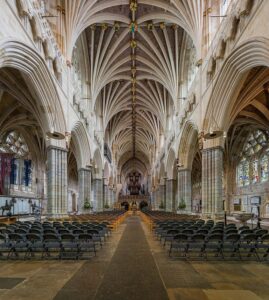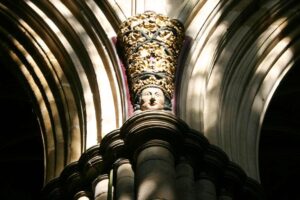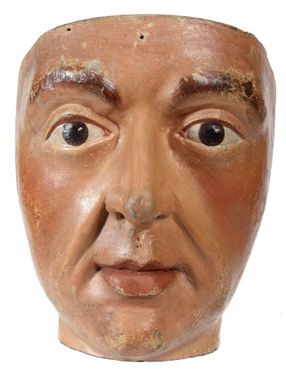
In this post I present detailed evidence to support my contention that, surprisingly, the corbel carvings in the nave of Exeter Cathedral have represented, at various times and different places over the centuries, two lots of people.
I believe they were originally of Norman and Angevin monarchs and were in Old Westminster Abbey, but were salvaged from there when this started being demolished in 1245 prior to its rebuild over the following twenty or so years by Henry III. Presumably they then languished in some depot or in the Tower of London for some years while people wondered what to do with them, or more likely almost forgot about them.
In the early 1350s the then Bishop of Exeter, John de Grandisson, needed a set of carvings to complete the nave and the splendid barrel roof of the rebuilt cathedral. To save money and, very likely because no stone carver of sufficient skill was available following the Black Death, which had ravaged the Kingdom only a couple of years earlier, he decided it would be easier to reuse existing carvings by adding suitable extra layers of plaster and paint. The revamped carvings would represent Edward III and members of his family, including the Black Prince, and the bishop himself and his wife.
I suggest that de Grandisson learned of the Norman carvings put aside and was able to acquire them. In positioning them, he ingeniously managed to preserve the order of succession of their original Norman identities, from West to East along the nave, perhaps out of respect for who he knew they had been, while achieving a felicitous arrangement of their new identities, given the choice he had to make of who would best correspond to who from their physical similarities.

Three hundred years later, in the 1650s, when richly ornate and gilt carvings were no longer fashionable or even tolerated, de Grandisson’s surface alterations were scrubbed and scraped away, leaving the original Norman identities. By then few would have guessed who these were, or in the unlikely event they did were (luckily) symathetic and kept quiet about the new identities uncovered, because carvings of monarchs would not have been welcome in Cromwell’s republic! Perhaps they were presented as Old Testament characters such as Saul, David, and Samuel, etc.
The carvings remained a drab grey and indistinct, and anonymous, until modern times when they were repainted once more, only a few years ago I gather. The lady entrusted with this task did a splendid job and really brought them to life. But, not knowing the carvings’ identities, she understandably chose the wrong colours for the hair and beards of some.
My evidence mostly relates to their present (and thus original) appearance, based on comparisons with contemporary descriptions of the monarchs I claim they represent, and the few surviving representations of them, which are mostly copies of originals. The evidence for their intermediate identities, between c 1350 and 1650, is ably provided in [Ottery]. So I have little to add to that.
Tying the two together is solely my conjecture, although I hope a well-disposed reader will agree in the end that it is plausible, and that in fact it would be hard to find any other explanation that accounts for all the features, including a couple of strange anomalies, of their present disposition.
A corollary of this, if true, is that for once the mighty Wikipedia is wrong! Its article on William the Conqueror states that “No authentic portrait of William has been found”. However, as I hope to convince the reader, an accurate carving of him, very likely the last that still exists, looms over the western door of the cathedral as large as life!

Besides the corbel carving, which I claim is his, and very likely the most accurate, I am aware of only four surviving representations of William I’s face, in increasing order of likely accuracy:
- Contemporary coins (hardly accurate at all, but a few may be vaguely suggestive)
- Bayeux tapestry (maybe slightly more accurate than coins, but not much)
- 17th century copy of earlier wooden face mask in Tower of London
- Engraved copy of now lost painting of him and family on chapel wall in Abbey of St Stephen, Caen
The Tower of London houses a copy of earlier wooden mask of William I. This copy was produced in the 1680s from an original that was by then in very poor shape and (to my knowledge) no longer exists. The facial features are likely a fairly accurate reflection of the original, but the same certainly cannot be said of the head shape.
It seems new copies of several masks of former sovereigns were produced for a public exhibition planned by King James II somewhat similar to a waxworks display. His aim was a foolish and outdated desire to extol the merits of absolute monarchy and try to restore it. He had evidently learned nothing from the then recent grim fate of Charles I, who had also tried to maintain the divine right of kings past its sell by date!

In those days people had firm ideas about what constituted an aristocratic head shape, and that was a narrow head. So, given the propaganda aims of the exhibition, if William’s original mask had an embarrassingly broad and robust face shape and lantern jaws, like a peasant’s by the refined standards of the day, then they would have thought nothing of making those of the copy much narrower and flatter, with a suitably delicate small jaw! Also, in fairness, the original may have eroded and shrunk, or lost outlying parts, to a point where the overall head shape was no longer obvious.
The superficial features of this face include: prominently arched eyebrows, a straight nose, full mouth, and cold supercilious eyes. But (predictably!) the head shape is narrow, with no prominent cheekbones nor a lantern jaw nor even jowls. This is not the face of the corpulent person William I became in his final years, possibly letting himself go somewhat and comfort eating following the death of his wife Matilda in 1083, three years before William’s death.
12th century carvings v 14th century rebuild
On the face of it, the fact that the barrel roof was not built until the 1350s is a conclusive objection to a claim that carvings which are an integral part of it can be from the 1100s, because the foliage above the carved heads definitely follows the present curved ceiling arches and thus could not have been present in the original Norman cathedral.
However, again, my proposal explains this if the carved heads were taken from elsewhere and reused at the time the roof was rebuilt.
A keen researcher, willing to root through old parchments in Exeter Cathedral library or in the records of Westminster Abbey (a task I have neither time nor skill to undertake), could perhaps confirm whether a stonemason was paid for the relevant corbel carvings as part of the cathedral rebuild. If not then, like “the dog that didn’t bark in the night”, that would tend to support my contention that these already existed from earlier times.
But note that the foliage adornments would have needed freshly carving. These carvings are exquisitely done, and to the uninitiated (such as myself) this achievement looks hideously difficult and complicated, more so even than carving faces, given the deep and convoluted 3D structures required. But it may be one of those skills that are actually fairly simple and routine with practice, and the carving of accurate life-like faces that is the more subtle and demanding task.
There’s much more to read on this subject. Click HERE for the full article.